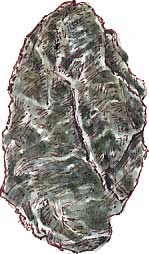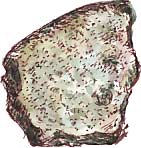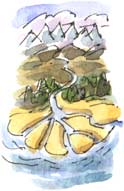



Richard Bell's Wild West Yorkshire Nature Diary, Wednesday, 4 yAugust 2010




 DRAWING
A PEBBLE is like exploring a landscape in miniature. This sketch (left)
could be of a slate quarry in a Welsh hillside but it's actually a close
up of the piece of slate (right) which I picked up
from a decorative bed at the kerbside as we turned up at the hospital this evening.
DRAWING
A PEBBLE is like exploring a landscape in miniature. This sketch (left)
could be of a slate quarry in a Welsh hillside but it's actually a close
up of the piece of slate (right) which I picked up
from a decorative bed at the kerbside as we turned up at the hospital this evening.
Like the north Welsh landscape, this hand specimen bears the marks
of some 500 million years of Earth's  history.
The fine-grained sediment was laid down on the ocean bed as the proto-continents
which would eventually form the supercontinent Pangaea came together. The structure
of the rock is due to the pressure that the sediment was later subjected to
as two continents came together, closing the ocean between them. This is what
geologists refer to as slaty cleavage and doesn't reflect the
original layers in which the muddy sediment was deposited.
history.
The fine-grained sediment was laid down on the ocean bed as the proto-continents
which would eventually form the supercontinent Pangaea came together. The structure
of the rock is due to the pressure that the sediment was later subjected to
as two continents came together, closing the ocean between them. This is what
geologists refer to as slaty cleavage and doesn't reflect the
original layers in which the muddy sediment was deposited.

 Mountains
were thrown up in the final stages of this continental collision and that's
where this sandstone pebble comes in; granite, which formed
as molten masses during mountain building, was the source of the quartz and
feldspar that make up this pebble.
Mountains
were thrown up in the final stages of this continental collision and that's
where this sandstone pebble comes in; granite, which formed
as molten masses during mountain building, was the source of the quartz and
feldspar that make up this pebble.
In this case the original layers in which the sand was deposited have influenced
the shape of the pebble. This is a broken fragment but the original pebble was
flat, like a discuss, perfect for skimming across the water in the game of ducks
and drakes.